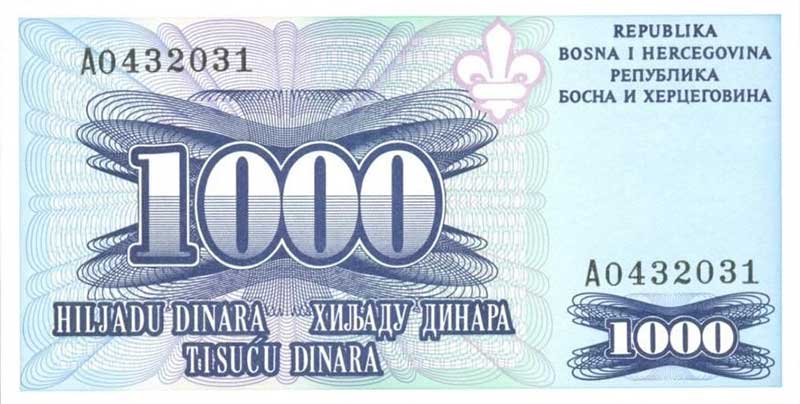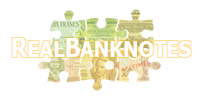The Forgery Made by the Government

While browsing the gallery of the banknotes of Bosnia and Herzegovina, one could notice that one series design is repeated three times, namely P-10 to P-17, P-39 to P-46 and P-47 to P-47C, although in different sizes. In turbulent times, as was the case in Bosnia in the 1990s, it is nothing unusual and there are many other such cases in the galleries for other countries. So then, What makes this case special?

The first and the second were issues were regular Bosnian and Herzegovinian dinar series, issued by the National Bank of Bosnia and Herzegovina (NBBH) in 1992 and 1994 respectively, but the third one is undated, never circulated and described in the Standard Catalog of World Paper Money as produced in 1995 and printed by "Thomas de la Rue" in London. The exact story of this series may never be completely revealed, since the National Bank does not exist any more (it was replaced by the Central Bank in 1998) and "Thomas de la Rue" does not issue statements without the approval of the ordering bank. The persons that were included in the process remain silent - since any information they might bring forward could cause the emergence of some unpleasant questions for them.
This text is based on two articles, the first by Amer Sulejmanagic "Bosnian and Herzegovinian Banknotes Printed in England" pages 9-13, and the second by Jusuf Mulic and entitled "London Issue of Bosnian-Herzegovinian Dinar From 1992", pages 14-19, both published in Bosnian in "Novi Numizmaticar", Nr. 3, Sarajevo, 2004, with some factual correction and synchronization. Here we list what is known:
On the banknotes there is the the assumed signature of "Stiepo Andrijic", the governor of the NBBH between 25.5.1992 and 10.10.1993. However, the signature of the last series is not truly the signature of Mr. Andrijic, as his actual signature can be seen on Bosnia and Herzegovina banknotes P-10 to P-15. Therefore, it appears as though someone had to forge his signature, and to approve such an act to the printer.
The governor of the NBBH prior to Mr. Andrijic was Ms. Hajra Balorda, who was politically not in line with the government of the Republic, one that had declared its independence from Yugoslavia after the public vote on 29.2. and 1.3.1992. Therefore the Government or the Ministry of Finances could have started the preparation for their own currency even then, negotiating with Thomas de la Rue and Cetis Security Print Celje (Slovenia), the printers that had printed P-10 to P-15, while keeping the Governor completely out of the loop.
The third series has actually three developmental sub-variants not listed in the Standard Catalog of World Paper Money, with the first being signed by Jure Pelivan as the "governor". Mr. Pelivan was the prime minister of Bosnia from 20.12.1990 to 9.11.1992. He claimed he knew of the printing, but that he did not have anything to do with this but that he knew of an unnamed Bosnian diplomat serving in 1992 in Turkey who had obtained money for the printing from some incognito donor.
Some amount of 50 and 1000 dinar notes with numeration arrived to Bosnia in 1995, but these were withdrawn to the Treasury and destroyed. The third series was printed in the same quantity as the first series, but the NBBH was not willing to take receipt of the rest the banknotes in 1996 or 1997 on call of the Printer, with the exception of some examples for the NBBH collection. The rest of the banknotes were said to have been be destroyed.
Therefore this issue has to be observed simultaneously as an official issue and as a forgery - where the forger was the government itself, which is quite a rare case.
Mr. Mulic asked two possibly unpleasant questions:
- 1. Who approved the forging of the signature?
- 2. Who expropriated the notes that today could be bought on the notafilic market?
Further questions that could naturally follow:
- 3. Who approved the transfer of (assumed) 2.5 million German marks to pay for the printing and from which source?
- 4. Why there were two simultaneous orders to print the banknotes, with the same design done by Bosnian painter Dzevad Hozo?
There can be several related question along these lines.
There are no known numerated examples of the 500 dinar note (P-47B, only printers proof banknotes), while the numerated 100 dinar (P-47A) is very rare, as are its proofs. There are a lot of 50s (P-47) on the market, while the 1000 (P-47C) got expensive as of late. In my opinion some dealers stocked them and sell them slowly over time to manipulate the market and keep prices high.





